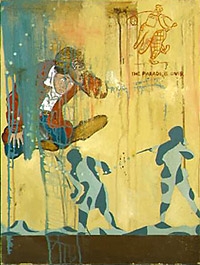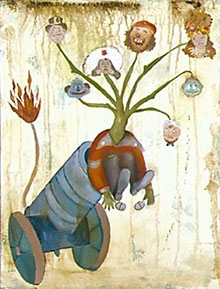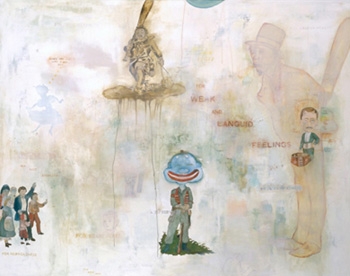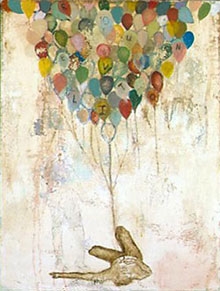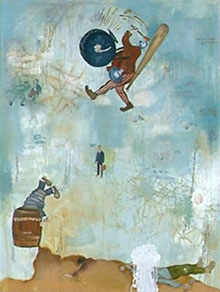Feature: Reviews
Juan Carlos Quintana: Blinded by Omnipotence
- John Berggruen Gallery
- San Francisco
- June 3 - July 10, 2004
False Notes
If I were to speak to Juan Carlos Quintana about these paintings, I’d ask him “Why is cartoon imagery profound?” Even as the handling of such representation seems infinitely absorbent of innovation, these paintings’ misplaced irony distances us as viewers, making their sincerity a lingering question. But I am grateful they exist at all.
They hint at complex issues such as colonialism and racial stereotyping, but allow its “signs” to remain fashionably ambiguous. Ghoulish clowns, militarists, Carmen Miranda, cigar and plantation advertising motifs, and political caricatures float on undifferentiated, cloudy, “painterly” space. Without three-dimensional space indicated, it’s difficult to conceive of time; and these are—in many ways—historical paintings. Similarly, without three-dimensional space, not only are the images floating, the viewer and the painter are as well. Signs of racism are presented ideologically and materially without a position; perhaps too “lite” a read on grave situations. Furthermore, unless Quintana claims “Omnipotence”, somehow demarcating his experience would lend these works credibility. His style is dream-like, which works with the anxiety of the nightmarish imagery, but a dreamer is necessary to give these attractive works seriousness. Such subject matter deserves a hierarchy of signifiers that resolve the two-dimensional plane on which they exist, for is it not the new juxtaposition of signifiers that creates the new meaning? I feel his “authorless” juxtapositioning leaves us in a land where things really do mean nothing—and that is not what these overtly ethically-minded works promise.
In something of a regional school (which I’m sure the long view of art history will duly note) Bay Area artists like Juan Carlos Quintana, Enrique Chagoya, David Huffman, and Manuel Ocampo (and others represented by Babilonia 1808, for example) pick up where identity politics (generally in more alternative styles) left off in the ‘90s and resuscitate 18th and early 19th-century History Painting. At its best, the style is often grounded by the first-person experience of sons or daughters of parents who at one time knew colonialism (or the legacy of it, including the institutions of slaveries, overt and covert.) They paint from the vantage of/and represent those who would constitute the invisible “conquered” in a victorious battle scene by, say, Poussin. Their stylistic innovations—use of an abstract painterly background populated by signifiers or the representation of weathered-looking cartoon signs, emblems, banners, and type—can also be seen in the work of Chris Johanson and Barry McGee.
But the former group GENERALLY achieves something of more art historical import by stepping into the vacuum “History Painting” left. However, when the form of political critique is adopted, the responsibility to wrestle with identity may come with it…and this illumination is what is missing from the works under discussion here.
Though I can nibble on an image here and there, I cannot resolve the poetry embedded in many works. A story, in time, might be just more direct. For example, Relatively Non Discreet Use of Aggression (2004). It seems too facile, yet almost sketched. It is comprised of six figures, in an intentionally random arrangement, floating on a shallow space, and the phrases: “Where are you when a need you?” (uttered by a curtseying silhouette); “tu servicio” (a ghoulish military clown;... “for nervousness…” (under an illustrational group from the remote past) and “for weak and languid feelings (big, just between figures), all handwritten, so no clue there as to, for example, power relations between the figures, inner and outer life, time sense, etcetera. Without Quintana’s story the journey which he obviously has undergone to make and show these works remains theoretical.
The same compelling beginning appears in many of the works in his show. I’d almost recommend it—if only to get frustrated, think a lot, and be prepared to see what he does next.
Juan Carlos Quintana: Blinded by Omnipotence is on view at John Berggruen Gallery at 228 Grant Street in San Francisco. For more information, call (415) 781-4629 or visit www.berggruen.com.

